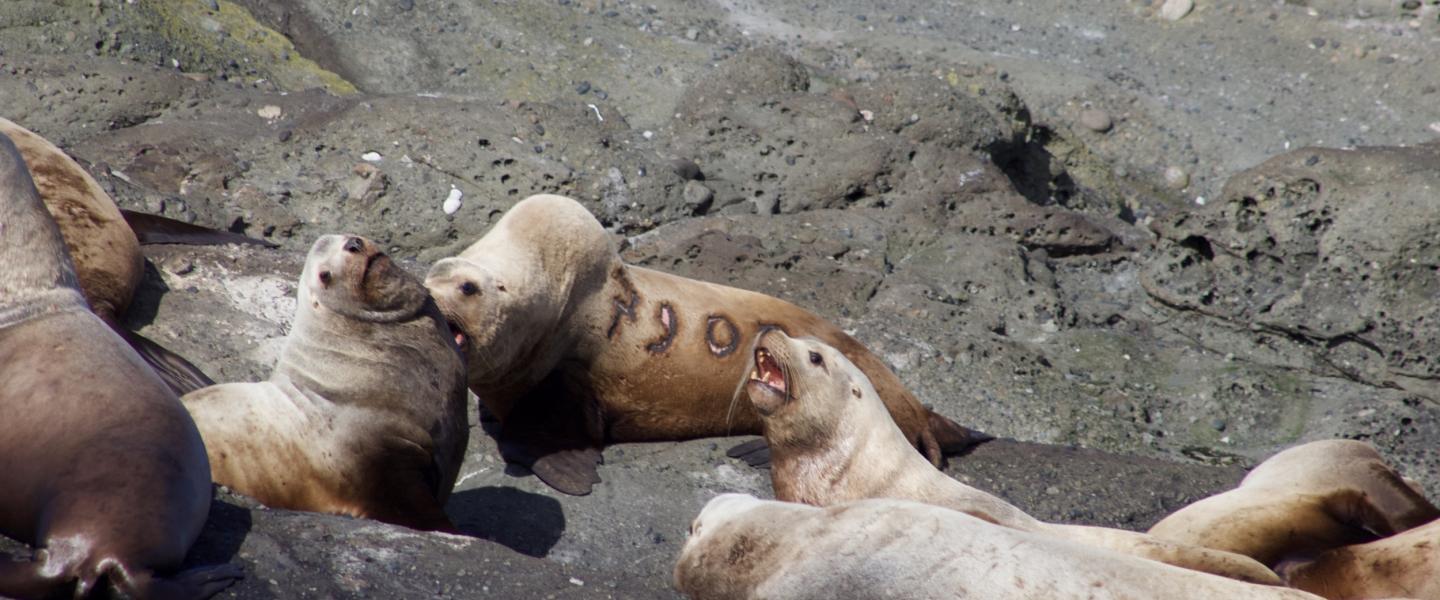
[Saturday, 3/3/18 – 12:00 – M/V Sea Lion – Naturalist Erick]
This Saturday, we headed out again on another rare, sunny spring day! Captain Mike and I took our small group of guests north towards the outer islands of the San Juans and the Southern Gulf Islands of British Columbia. We made our first stop at Green Point (the eastern-most point on Spieden Island just north of San Juan). Here at Green Point is a favorite haul out spot for our largest pinniped species and the largest Sea Lion (eared seal) species in the world – The Steller Sea Lion! They were really enjoying this nice, sunny day and soaking up the sun as much as they could. There were a few rafted together in the currents that were thermoregulating by holding one flipper out of the water and doing their best impression of a shark. This enables them to stay in the cool water but keep their less insulated parts – like their flippers – warm and in the sun. The ones that were fully out of the water and enjoying the warm rocks were very growly today and made it easy for me to explain to folks how different these sea lions sound from what we usually imagine when we think of sea lions – the California Sea Lions who make a ‘barking’ noise.
We soon started to scoot along the southern, grassy side of Spieden Island and found a veritable Serengeti waiting for us. This privately-owned island used to be a private, exotic game hunting reserve that people would come and pay to shoot large game that was shipped in from all over the world. This man eventually went out of business due to his island neighbors not liking all of the gunshots they heard and because of a rough stint of bad publicity. To save money he left a lot of animals behind and they are still living there. There are three nonnative species: Mouflon Sheep from the Mediterranean, Fallow Deer from Western Europe, and Sika Deer from Asia. As we traced the shoreline we saw huge herds of Mouflon sheep with their spiral horns grazing on the green lawn of the island’s south side. We also saw large groups of the Fallow Deer with their enormous antlers galloping underneath the gnarly Garry Oak groves. Interspersed with these herds of ungulates were Bald Eagles chilling on the steep, grassy slopes of the islands looking out over the shimmering green waters of the Salish Sea. How Magical!
After we were done with that little safari interlude we continued north and took a quick pit stop at Sentinel Rocks to look at all the sleepy Harbor Seals. They are close cousins to the large brown sea lions we just watched at Green Point, but these guys are quite a bit smaller and cannot walk around on land like their eared cousins can. SO they just lie and flop around. Hilarious. Next up, we went even further north!
We headed across Haro Strait to search around Gooch, Moresby, and South Pender Islands. We scanned the waters and shorelines around here and then went into the deeper waters of Boundary Pass and soon saw a group of very funny looking dorsal fins up ahead. We were about halfway in between Turn Point of Stuart Island and North Bay on Waldron Island’s coast. We approached the group of cetaceans (whales) and soon identified them as a pod of Dall’s Porpoises! These are a species of porpoise that only exist in the North Pacific and although we are in their overall range they are a rare treat for us. Currently they tend to prefer the waters just a little further north near Johnstone Strait in Canada. Their dorsal fins look funny because they do have little, white ‘frosted tips’ on the top of their fins. Their bodies also look like they have two dorsal fins when they come up to breathe. Mid-way along their hind end they have a bump - weird. Overall their entire bodies look different than other cetaceans. They are very chunky and have a black and grey patterning that makes them look a little bit like baby orcas even though they are not closely related and some of their tails take on an inverted fan shape different than the classic curved triangle of other whales. They are so cool! And whatever they are doing with their body shape it is working for them because they may be the fastest mammal in the ocean (orcas sometimes are faster). We watched this pod forage for fish for a while and got some great looks at their unique coloring and a few of the younger ones in the group. You can find a bit more information about this fascinating species here. After watching that pod we did, unfortunately, have to head back to port. Another excitingly different day out here! Until next time, folks!
Erick